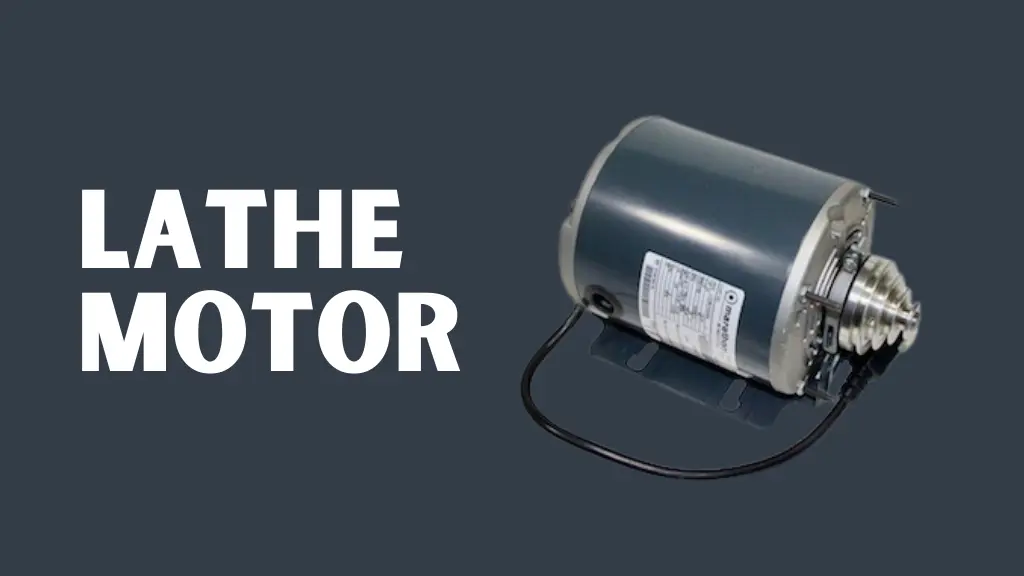Every lathe machine, whether it is in a large industrial shop or a small home workspace, depends on one key component: the motor. The motor is what gives the lathe its ability to rotate, cut, shape, and finish different materials. Without it, even the most advanced lathe becomes little more than a static machine. A reliable motor determines spindle speed, cutting power, and smoothness of operation, which all affect accuracy, efficiency, and the quality of the final work.
This guide takes a detailed look at lathe motors, explaining how they function, the types available, what specifications to consider, and how to keep them running in top condition. Real-world examples and expert insights are included to ensure this article goes beyond theory and provides practical value for machinists, hobbyists, and professionals alike.
What is a Lathe Motor?
A lathe motor is the power source that drives the spindle of a lathe machine. It converts electrical energy into mechanical energy, which is then transferred to the spindle through systems like belts, pulleys, gears, or direct drive setups. This rotational energy allows operators to cut, sand, drill, or polish workpieces depending on the task at hand.
The role of the motor goes beyond simply spinning the spindle. It influences the torque, speed control, and stability of the machine. A motor that is too weak may struggle to cut hard metals, while a motor with poor speed control can leave rough finishes in woodworking projects. Choosing the right motor is therefore not just a technical decision but also a practical one that affects every outcome in machining.
Importance of Motors in a Lathe
The lathe machine motor is often described as the heart of the machine because its performance defines the overall capability of the lathe. In woodworking, a motor that runs smoothly without sudden fluctuations allows operators to achieve polished and even surfaces. For metalworking, torque at lower speeds becomes critical because it ensures threading and cutting are done with precision rather than strain. In industrial environments, a durable and efficient motor is what makes it possible for machines to run long shifts without constant breakdowns or overheating.
Without a dependable motor, even a high-quality lathe loses its effectiveness. This is why machinists and workshop owners often invest in upgrading motors as a way to extend the life of their machines and improve output.
Types of Motors Used in Lathes
Different lathes use different motors depending on workload and precision requirements. AC motors are among the most common in larger machines because of their durability and ability to handle continuous operation. They are reliable and cost-effective, though they often need external controllers to allow variable speed adjustments.
DC motors, by comparison, are more popular in smaller lathes and hobby machines. They are valued for their excellent speed control and ability to provide strong torque even at lower speeds. However, they are usually more expensive and require a power converter when used with alternating current supplies.
In advanced computer-controlled lathes, servo motors are often the preferred choice. These motors provide extreme accuracy and fast responses, making them perfect for complex automated machining tasks. They are more expensive but deliver unmatched precision. Stepper motors are also used in some CNC lathes, particularly at the entry level. They are affordable and easy to control digitally, though they provide less torque and may skip steps under heavy loads.
Another option, mostly found in small or portable lathes, is the universal motor. It can run on both AC and DC power, and its compact size makes it convenient for lightweight machines. However, it tends to be noisy and less durable compared to other types.
Key Specifications to Consider
When selecting a lathe motor, it is essential to consider more than just horsepower. Horsepower indicates the strength of the motor and must match the type of work the lathe is expected to perform. For example, small hobby lathes may only need a motor rated between a quarter and half a horsepower, while mid-sized machines generally benefit from motors between three-quarters and two horsepower. Large industrial lathes often require three horsepower or more to handle demanding workloads.
Torque is another important factor. When cutting hard materials like stainless steel, torque ensures that the motor does not stall or struggle at lower speeds. A motor with sufficient torque provides smoother performance and better control during heavy operations.
Speed range is equally critical. Wood lathes typically operate between 500 and 4000 revolutions per minute, while metal lathes work best between 50 and 2000 revolutions per minute. CNC lathes, on the other hand, can precisely control speeds through software adjustments.
Voltage requirements also vary. Hobbyist machines often run on standard household power at 110 volts, while industrial machines may require 220 volts or higher. Finally, the type of motor enclosure matters. Open frame motors cool easily but are vulnerable to dust. Totally enclosed fan-cooled motors, commonly referred to as TEFC, provide more protection in dusty workshops. Explosion-proof motors are necessary for hazardous environments where sparks could be dangerous.
Real-World Application
A machinist working on a mid-sized lathe with an older one-horsepower AC drive system may encounter difficulties when threading harder metals. Upgrading to a two-horsepower DC drive system provides better torque and smoother variable speed control, making challenging operations significantly easier. The threading process becomes more precise, tool chatter is minimized, and the surface finish on the workpiece improves noticeably.
This real-world improvement highlights the importance of matching the drive system to the specific demands of the work. Selecting the right lathe drive system ensures both efficiency and durability, enabling operators to take on more complex projects while extending the machine’s overall lifespan.
Maintenance Tips
Maintaining a motor properly is essential for extending its lifespan and ensuring safety. Dust and debris can accumulate quickly in a workshop environment, which is why regular cleaning of vents and exterior surfaces is necessary. Bearings should be lubricated to minimize friction and prevent premature wear. Belts and pulleys must be inspected often, since worn or misaligned parts can lead to vibration and reduced efficiency.
Electrical wiring is another area that requires attention. Frayed wires or loose connections can cause overheating or sudden power failures. Paying attention to unusual sounds, such as grinding or rattling, can also prevent larger issues because these noises often signal failing bearings or other mechanical problems.
Common Issues and Troubleshooting
Lathe machine motors, like any mechanical component, can occasionally develop issues that affect performance. If a motor refuses to start, the problem is often related to faulty wiring, a blown fuse, or a tripped breaker. Overheating is another common issue and may occur due to overloading the machine, poor ventilation, or excessive dust accumulating inside the motor.
Strange or unusual noises typically point to worn bearings that require replacement or proper lubrication. Vibration during operation is often caused by misaligned pulleys or a loose motor mount, which can affect precision and safety. Low torque output may indicate voltage supply issues or worn brushes in DC motors. By identifying and addressing these problems early, operators can prevent extended downtime, reduce repair costs, and ensure the motor continues to run reliably.
Safety Considerations
Working with a lathe motor requires a disciplined approach to safety to protect both operators and equipment. The motor must always be disconnected from its power source before maintenance to prevent electric shock or accidental start-up. Enclosures and protective covers play an important role in shielding the motor from dust, sparks, and debris that can impact performance. Experienced machinists also recommend avoiding operation beyond the rated capacity, as overloading increases the chances of overheating and long-term mechanical failure.
Industry standards stress the importance of integrating safety features, particularly emergency stop switches, which should always be installed within easy reach. These allow quick shutdowns during unexpected hazards, reducing the risk of serious accidents. Following OSHA-recommended protocols and trusted manufacturer guidelines ensures the safe handling and longevity of the motor.
Choosing the Right Motor
Replacing or upgrading a motor involves more than simply picking one off the shelf. Compatibility with the lathe frame and control systems must be checked carefully. Voltage and phase requirements need to be matched with the workshop’s electrical supply. Torque, horsepower, and speed range should be evaluated based on the type of materials being machined.
Cost is also an important factor, but it should always be weighed against reliability and long-term performance. Choosing a slightly more expensive but well-supported motor can save both time and money in the long run.
Case Study Industrial Upgrade
At a mid-sized manufacturing facility, heavy-duty lathes frequently overheated, causing unexpected downtime and slowing production. Engineers analyzed maintenance records, operational logs, and energy usage to identify the problem. The assessment revealed that the older motors could not handle the constant load required for metalworking. This inefficiency directly affected both productivity and operational costs.
The facility upgraded to more powerful, totally enclosed fan-cooled motors designed for high-demand industrial use. After installation, downtime decreased by nearly 50 percent, and machines ran more smoothly. Energy efficiency improved, and maintenance needs dropped significantly. The investment paid for itself in under a year, showing how the right motor can boost productivity and long-term profitability.
Conclusion
The motor is the driving force behind every lathe machine. It determines not only how smoothly and efficiently the machine operates but also the quality of the final product. From hobby projects to large-scale industrial work, the right motor ensures accuracy, reliability, and safety.
By understanding lathe motor types, specifications, and maintenance requirements, operators can make informed decisions that extend the life of their machines and improve their results. Whether choosing an AC motor for durability, a DC motor for flexibility, or a servo motor for precision, the key is to balance performance with long-term value.
For further technical information about electric motors, readers can explore the comprehensive overview available from Britannica on electric motors.
Frequently Asked Questions
What size motor is best for a wood lathe?
Most wood lathes perform well with motors ranging from half to two horsepower depending on the size of the projects.
Can an AC motor be replaced with a DC motor?
Yes, it is possible, but it often requires new wiring, a speed controller, and in some cases adjustments to the motor mount.
What is the typical lifespan of a lathe machine motor?
With proper maintenance, a quality motor can last anywhere from ten to twenty years in workshop environments.
How often should the motor be serviced?
Routine inspections every six months are advisable, with full servicing at least once a year.
Are CNC motors different from manual lathes motors?
Yes, CNC lathes often use servo or stepper motors because they allow highly precise computer-controlled movements.




